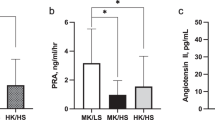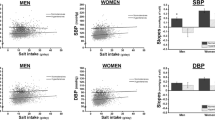Abstract
The metabolic syndrome is a predictor of type II diabetes mellitus and cardiovascular disease. The mechanisms of the increased blood pressure (BP) in patients with the metabolic syndrome are poorly understood. We investigated if salt-sensitivity is a characteristic of the metabolic syndrome. A total of 301 subjects (87male subjects, 214 female subjects) of 41.5±0.7 years of age completed a salt sensitivity test, and were evaluated for the presence of metabolic syndrome. BP and 24-h sodium excretion were obtained under usual, high- and low-salt intakes. BP reactivity to salt was markedly increased in subjects with the metabolic syndrome; its magnitude was directly related to the severity of the syndrome. Reducing dietary salt from the average usual intake (8.2 g/day) to nearly 2.3 g/day lowered systolic blood pressure (SBP) by 8.7±1.3 mm Hg in subjects with four and five traits, 6.0±1.1 in those with three traits and failed to modify the BP of subjects with one or no traits of the syndrome (P<0.0001). Salt restriction reduced the percentage of subjects with metabolic syndrome that were hypertensive (8.2 g/day of salt) from 23.8 to 8.2% (χ2: 23.6; P<0.0001). BP of non-hypertensive subjects with metabolic syndrome was also significantly reduced by salt restriction (7.1±1.5 and 4.2±1.1 mm Hg in those with four or five traits and three traits, respectively). In conclusion, the metabolic syndrome is a strong clinical predictor of salt sensitivity. The enhanced BP reactivity to dietary salt observed in subjects with the metabolic syndrome, may determine the increased BP levels commonly associated with the syndrome.
This is a preview of subscription content, access via your institution
Access options
Subscribe to this journal
Receive 12 digital issues and online access to articles
$119.00 per year
only $9.92 per issue
Buy this article
- Purchase on Springer Link
- Instant access to full article PDF
Prices may be subject to local taxes which are calculated during checkout


Similar content being viewed by others
References
Haffner SM, Valdez RA, Hazuda HP, Morales PA, Stern MP . Prospective analysis of the insulin-resistance syndrome (syndrome X). Diabetes 1992; 41: 715–722.
Liese AD, Mayer-Davis EJ, Tyroler HA, Davies CE, Keil U, Duncan BB et al. Development of the multiple metabolic syndromes in the ARIC cohort: joint contribution of insulin, BMI, and WHR: atherosclerosis risk in communities. Ann Epidemiol 1997; 7: 407–416.
Lakka HM, Laaksonen DE, Lakka TA, Niskanen LK, Kumpusalo E, Toumilhehto J et al. The metabolic syndrome and total and cardiovascular disease mortality in middle-aged men. JAMA 2002; 288: 2709–2716.
Malik S, Wong ND, Franklin SS, Kamath TV, L'Italien GJ, Pio JR et al. Impact of the metabolic syndrome on mortality from coronary heart disease, cardiovascular disease and all causes in United States adults. Circulation 2004; 110: 1245–1250.
Hunt KJ, Resendez MA, Williams K, Haffner SM, Stern MP, San Antonio Heart Study. National cholesterol education program versus world health organization metabolic syndrome in relation to all-cause and cardiovascular mortality in the san antonio heart study. Circulation 2004; 110: 1251–1257.
National cholesterol education program: executive summary of the third report of the National Cholesterol Education Program (NCEP) Expert Panel on Detection, Evaluation, and Treatment of the High Blood Cholesterol in Adults (ATP III). JAMA 2001; 285: 2486–2497.
Weinberger MH . Sodium and volume sensitivity of blood pressure. Age and pressure change over time. Hypertension 1991; 18: 67–71.
Luft FC, Miller JZ, Grim CE, Fineberg NS, Christian JC, Daugherty SA et al. Salt sensitivity and resistance of blood pressure. Age and race as factors in physiological responses. Hypertension 1991; 17: 1102–1108.
Campese VM . Salt sensitivity in hypertension, renal and cardiovascular implications. Hypertension 1994; 23: 531–550.
Morimoto A, Uzu T, Fujii T, Nishimura M, Kuroda S, Nakamura S et al. Sodium sensitivity and cardiovascular events in patients with essential hypertension. Lancet 1997; 350: 1734–1737.
Coca A, De la Sierra A . Salt sensitivity and left ventricular hypertrophy. Adv Exp Med Biol 1997; 432: 91–101.
Weinberger MH, Fineberg NS, Fineberg SE, Weinberger M . Salt sensitivity, pulse pressure, and death in normal and hypertensive humans. Hypertension 2001; 37 (Part 2): 429–432.
Bihorac A, Tezcan H, Ozener C, Oktay A, Akoglu E . Association between salt sensitivity and target organ damage in essential hypertension. Am J Hypertens 2000; 13: 864–872.
Weinberger MH . Salt sensitivity is associated with an increased mortality in both normal and hypertensive humans. J Clin Hypertens (Greenwich) 2002; 4: 274–276.
Rocchini AP, Key J, Bondie D, Chico R, Moorehead C, katch V et al. The effect of weight loss on the sensitivity of blood pressure to sodium in obese adolescents. N Engl J Med 1989; 321: 580–585.
Sharma AM, Ruland K, Spies KP, Distler A . Salt sensitivity in young normotensive subjects is associated with a hyperinsulinemic response to oral glucose. J Hypertens 1991; 9: 329–335.
Zavaroni I, Coruzzi P, Bonini L, Mossini GL, Musiari L, Gasparini P . Association between salt sensitivity and insulin concentrations in patients with hypertension. Am J Hyperten 1995; 8: 855–858.
Fuenmayor N, Moreira E, Cubeddu LX . Salt sensitivity is associated with insulin resistance in essential hypertension. Am J Hyperten 1998; 11: 397–402.
Galletti F, Strazzullo P, Ferrara I, Annuzzi G, Rivellese AA, Gatto S et al. NaCl sensitivity of essential hypertensive patients is related to insulin resistance. J Hyperten 1997; 15: 1485–1491.
Reaven GM . Role of insulin resistance in human disease. Diabetes 1988; 37: 1595–1607.
Reaven GM . Relationships between insulin resistance and hypertension. Diabet Care 1991; 14: 33–38.
Elliott P . Observational studies of salt and blood pressure. Hypertension 1991; 17: I3–I8.
Malik S, Wong ND, Franklin SS, Kamath TV, L'Italien GJ, Pio JR et al. Impact of the metabolic syndrome on mortality from coronary heart disease, cardiovascular disease, and all causes in United States adults. Circulation 2004; 110: 1245–1250.
Deng AY . In search of hypertension genes in Dahl salt-sensitive rats. J Hypertens 1998; 12: 1707–1717.
Fornoni A, Raij L . Metabolic syndrome and endothelial dysfunction. Curr Hypertens Rep 2005; 7 (2): 88–95.
Yamagishi S, Nakamura K, Jinnouchi Y, Takenaka K, Imaizumi T . Molecular mechanisms for vascular injury in the metabolic syndrome. Drugs Exp Clin Res 2005; 31 (3): 123–129.
Blaj S, Stanciu S, Jurcut C, Ciobica L . Hypertension in obese patients: a dysmetabolic hypertension with a possible adipocyte dysfunction mechanism. Rom J Intern Med 2003; 41 (2): 103–111.
Wisse BE . The inflammatory syndrome: the role of adipose tissue cytokines in metabolic disorders linked to obesity. J Am Soc Nephrol 2004; 15 (11): 2792–2800.
He FJ, MacGregor GA . Effect of longer-term modest salt reduction on blood pressure. Cochrane Database Syst Rev 2004; 3, CD004937.
Chobanian AV, Bakris GL, Black HL, Cushman WC, Green LA, Izzo JL et al. The Seventh Report of the Joint National Committee on Prevention, Detection, Evaluation, and Treatment of High Blood Pressure: the JNC 7 report. JAMA 2003; 289 (19): 2560–2572.
Acknowledgements
Support: FONACIT S1-2001000679; CDCH-F.06.00.6248.2006 to ISH, and NSU President's Faculty Scholarship Award to LCX.
Author information
Authors and Affiliations
Corresponding author
Rights and permissions
About this article
Cite this article
Hoffmann, I., Cubeddu, L. Increased blood pressure reactivity to dietary salt in patients with the metabolic syndrome. J Hum Hypertens 21, 438–444 (2007). https://doi.org/10.1038/sj.jhh.1002153
Received:
Revised:
Accepted:
Published:
Issue Date:
DOI: https://doi.org/10.1038/sj.jhh.1002153
Keywords
This article is cited by
-
Molecular biochemical aspects of salt (sodium chloride) in inflammation and immune response with reference to hypertension and type 2 diabetes mellitus
Lipids in Health and Disease (2021)
-
Sodium sensitivity of blood pressure in Chinese populations
Journal of Human Hypertension (2020)
-
Chapter 3: Management of progression and complications of CKD
Kidney International Supplements (2013)
-
Chapter 5: Referral to specialists and models of care
Kidney International Supplements (2013)
-
References
Kidney International Supplements (2013)



